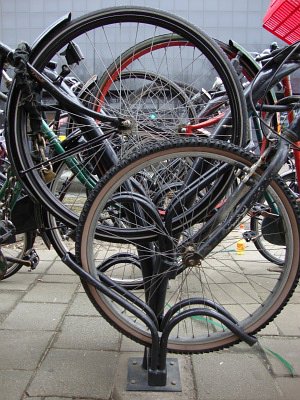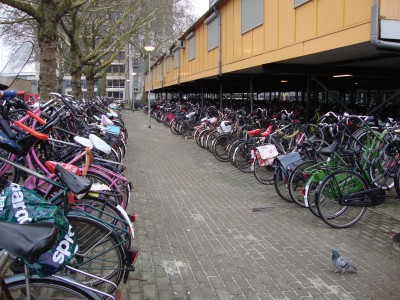Civility and infrastructure.
“The bicycle is the noblest invention of mankind.” William Saroyan, ‘The Noiseless Tenor’.

Rotterdam (Netherland) bike rack - photo by Robert Hothan.
Often when discussing sustainable living, transportation within our built environment becomes a focal point, as it is responsible for 28% of our nation’s energy use. The preferred mode of transport is motor vehicle. As an avid bicyclist and sustainability researcher, I have several opinions about the bicycling mode of transport. When I ask people why they don’t bicycle, the reply is often, “It’s too dangerous.” This article will address this concern.
A strong advocate of bicycle use is Ken Kiefer www.kenkifer.com/bikepages. According to his website Ken has logged over 100,000 bicycle miles. He writes about bike safety, “…we have to acknowledge that there are between 700 and 1,000 (bicycle) fatalities in the USA each year, which is a small number compared to the million or so who die from disease that cycling could help prevent and approximately 150,000 people killed in other kinds of accidents.” He also explains that bicycling accidents are likely to occur to the inexperienced bike riders, and those who operate in an unsafe manor. Tragically, in 2003 Ken was killed on his bicycle when struck by a car, he was 57. The operator of the motor vehicle was under the influence of drugs and alcohol.
I write about Ken to show that although the many miles of experience helps make one a safer rider, it also increases the exposure to a fatal traffic accident. Having the opportunity to bike in other parts of the developed world, Berlin, Amsterdam, Munich, Vienna and the countryside in between, I have lived the European bike network. The infrastructure is far more civil when compared to the USA. Cars and bicycles typically do NOT share the same roadway. This increases the pleasure and the safety of bike riding. Thereby increasing the amount of persons who cycle, which then increases the public awareness, which increases the safety of bike riding, which increases the amount of cycling. A sustainable positive feedback loop is created, but the first step needs to be taken. That step is for our nation to acknowledge that as simple as it is, bicycling is a sustainable form of transport. But it’s not sustainable when combined with an infrastructure that places bikes in the path of motor vehicles.
Europe was not always bike friendly.
According to the report ‘Making Cycling Irresistible: Lessons from The Netherlands, Denmark and Germany’, (2008) Transport Reviews, 28:4, 495 — 528 Bloustein School of Planning and Public Policy, Rutgers University, New Brunswick, New Jersey, USA.

Rotterdam (Netherland) bike rack at Rail Station - Photo by Robert Hothan
The present daily average of kilometers cycled in the Netherlands is 2.5 per person per day, compared to the USA of 0.1 km per day. For those of us who are metrically challenged, that is the equivalent of only 300 feet. Holland, Denmark and Germany between 1950 and 1975 began to see a dramatic decline in bicycle use. The Dutch bicycling council reports 66% less usage during that time, and a study in Berlin reports a 78% decline. During this period these developed countries focused on increased car use, expanding roads, and parking with little regard to pedestrians and cyclists. Sound familiar? After 1975 (recall oil shocks, environmental concern and safety) transport and land use policies progressed to accommodate the pedestrians and cyclists. And cycling use increased. The report states, “The most important approach to making cycling safe and convenient in Dutch, Danish and German cities is the provision of separate cycling facilities along heavily traveled roads and at intersections, combined with extensive traffic calming of residential neighborhoods.” P.30
Our nation has the perfect opportunity to follow suit, it has been proven and the recipe can be duplicated. Now, if only we can figure out a way to promote it as being “green.”